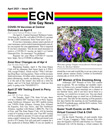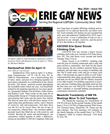That's Just Sad: The Standard American Diet
Because I am a geek, my idea of media "binge watching" involves streaming video from the proceedings of government committees involved in crafting guidelines for physical activity and nutrition. During my most recent trip into the fascinating world of behind-the-scenes science I was profoundly reminded of a fundamental concept: conflict of interest.
For the purposes of this series on food and LGBTQIA+ health, conflict of interest refers broadly to the influence of business on the science of nutrition. While beyond the scope of our topic area, bear in mind that some of what you hear portrayed on broadcast media as government approved scientific doctrine is heavily weighted on the side of powerful lobbying forces within the agricultural and food manufacturing sectors of this nation.
And why shouldn't it be thus? 300 years ago, 9 out of 10 Americans were farmers. While that number shrank to 3 out of 100 by Y2K, agriculture and associated industries including processing, manufacturing, and distribution delivered over one trillion dollars (with a t, folks) to our gross domestic product in 2017. What people eat has a real impact on a significant sector of our economy and anything that cuts into corporate profits is viewed as heresy by the boards of major corporations. So should a scientist stand up and say that there is no proof that drinking the modified sweat of industrially managed bovines is essential to health AND in fact evidence that consuming certain types of this product is detrimental, that scientist should be prepared to lose funding for research or much, much worse.
With that being said, let's have a look at how we 'Murricans are expected to eat today. Put aside Pinterest, cooking shows and the like; let's focus on a range of what is instead typical for the majority of us with a high school education or better living in households with an income ranging from 25 to 60 grand per year.
Pizza. Burgers. Fries. Potato chips, crackers, pretzels. Ice cream. Candy bars. Soda (or pop, depending on where you come from). Hot dogs. And apple pie, although chances are good that your mom didn't make it. Fast, cheap and often eaten with one hand while moving or staring at a screen, this style of consumption supports the frenetic pace of our lives. So how does how we actually eat compare with how we "should" eat?
Picture a salad plate, approximately 8 inches across (go ahead, grab a ruler, I won't tell). Divide that plate roughly into quarters. Half of the plate should be veggies. One quarter of the plate should be lean protein. One quarter should be some type of starch, preferably minimally processed, like a potato with the skin, brown rice, or a small whole grain roll. To the side of the plate add a medium piece of fruit and on the other side 8 ounces of 1% or less dairy (or other serving size of dairy product).
Hmmm. Where does the burger, fries and soda fit? Virtually nowhere. There is twice as much protein as recommended, no vegetables (I've seen you shaking off that pathetic shredded iceberg lettuce), and four times the recommended amount of carbohydrate from the white bread and deep fried processed potatoes. And no, the ketchup and sorry tomato slice do not count as a serving of fruit. The sodapop? Essentially it is a double helping of liquid candy infused with caffeine.
The typical American eats like a toddler, gorging themselves with products full of sugar, salt and fat not because they are morally flawed but because this is how our bodies evolved to survive in a world of complete and utter food insecurity. Famine and death by starvation are incredibly common in the so-called "natural world", and this reality shaped our chimpanzee relatives, our hunter-gatherer forbearers, and our early agricultural ancestors. Because food is scarce and hard to come by, our bodies are hard-wired to adore nutrient flavors and textures that provide the most calories with the least effort; this has ensured our survival in an extremely uncertain environment. And it case you think this environment is behind us, think again; over 800 million people around the world are either food insecure or living in starvation. Modern agriculture has not only employed our own biology against us by fostering overconsumption of heavily processed products it simultaneously reinforces global hunger by maintaining inefficient and unsustainable industrial practices.
Now you know. But what does it matter to YOU, personally? And if you want to change, what's the best way to go about revamping your approach to eating? Stay tuned, dear reader, stay tuned.
Until we meet again, be sure to eat the rainbow (colors of fruits and veggies, of course)!




